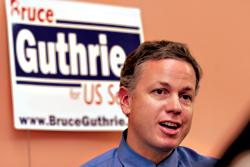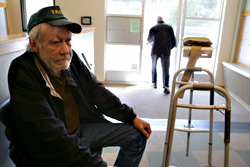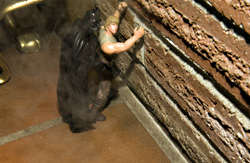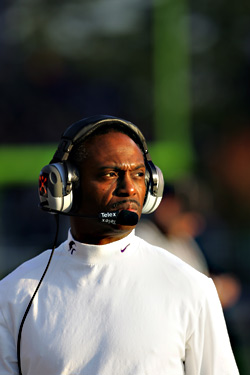Forget about the tear gas downtown. Forget about the tear gas on Capitol Hill. Forget about the batons to the back and the kicks to the groin and the sting-ball grenades and the pepper spray to the face. Forget, too, your own feelings about how the police handled this quasi-Waterloo. It’s all history.
Did the cops gain any wisdom from it?
“It was the perfect storm,” says Jim Pugel, a Seattle assistant chief of police. “Everyone learned.”
Pugel, a captain and West Precinct commander at the time, was in charge of the police response downtown. It was he, for example, who made the call to use tear gas on protesters on Nov. 30, 1999. He’d spent months preparing for the event, some of it spent reading material you’d likely never see in the hands of a cop—Saul Alinsky’s Rules for Radicals, a guidebook to engineering social change, and Gustave Le Bon’s classic The Crowd, a treatise on wild mobs in France. He still keeps them in his office at police headquarters.
As big a disaster as WTO was for almost everyone involved, it was a watershed moment for police here and nationally. In its wake, police respond to protests far more forcefully than in the recent past. No one wants the kind of property damage, for example, that took place in Seattle. Nowadays, whenever a city hosts a major meeting of the International Monetary Fund, say, or any other group likely to generate lots of pissed-off protesters, Pugel and other SPD officials hear from cops who are looking for ways to avoid the mistakes made in Seattle. Sometimes, they are flown in to act as consultants.
The advice is simple. Expect the worst. Expect thousands upon thousands of protesters to show up. Expect that some of them will be bent on damaging property and touching off riots. Although there were signs leading up to N30 that the response by protesters would be intense (property damage at the downtown Gap store weeks earlier, for example), no one in authority expected a protest on the scale of those in the 1960s.
“No one predicted what happened here,” says Pugel. “Not us, not the FBI. On a scale of 1 to 10, we predicted, at worst, a 7.” The FBI itself estimated that there was only a low to moderate likelihood for mayhem.
Perhaps the most crucial mistake at WTO, from a crowd-control perspective, was in not creating a buffer of fences several blocks in size around the conference site. Pugel says he requested fencing before the event. The request came back denied. Pugel won’t say who specifically denied it, but their reasoning was that there was no precedent in recent American history for creating a fortress around conference sites.
Either way, it was a dumb decision, as it ceded the high ground to protesters. And that’s what allowed thousands of them to get within spitball distance of WTO venues at the Convention Center and the Paramount Theatre, sit down in the streets, refuse to budge, and shut down the conference. To restart the WTO, police felt they had to use force and “less-lethal” munitions, as they are known. You know how that played out.
After Seattle, police in Los Angeles, New York City, and Washington, D.C., have made sure that there have been huge buffers around events such as the 2000 Democratic National Convention and this year’s GOP convention. It’s not a pretty sight, but it’s an essential one for cities that want to limit trouble.
The other fatal error in Seattle was to make mass arrests. Pugel advises against that. “It requires an incredible amount of police resources to do that, and it put a huge burden on prosecutors and the criminal-justice system,” he says. “Go after the instigators instead.”
There’s good reason to go after them, in Pugel’s mind. It prevents what’s known as the “contagion effect”—one protester, for example, throwing bottles at cops can set off an entire crowd.
But those are the easy pieces.
What really changed in the wake of WTO was that cops everywhere began to use pepper spray and all manner of less-lethal projectiles at protests large and small with far less discrimination than in the past. Their use in Seattle essentially green-lighted other police agencies to do the same thing. For example, on May 1, 2000, Portland police faced a peaceful street protest of 350 people. In the crowd were about three dozen Eugene anarchists—the presumed instigators of much of the trouble in Seattle—and when they wouldn’t cooperate with police, the cops opened up with beanbag shotguns and rammed the crowd with horses and ATVs, despite the fact that there’d been no property damage and little confrontation.
The use of less-lethal weapons is one of the most ticklish in crowd control. Use them indiscriminately, and the public regards you as thugs. Use them improperly, and someone could wind up dead. That’s what happened last month in Boston, when a bystander in the melee following the Boston Red Sox’s trouncing of the New York Yankees was hit in the eye with a pepper-spray pellet.
The lesson from Seattle, Pugel says, is that you shouldn’t use these weapons on entire crowds, as was done here, but should focus on individual troublemakers. It won’t make things look prettier, but it will prevent the kind of mass panic and mass anger that inflamed protesters at WTO.
There are other lessons as well. Some are serious—train your officers intensively, make sure any outside agencies that might assist have the same training, and trust them to do their job. Others are a bit more lighthearted. For example, many downtown restaurants offered food to weary cops, who were pulling 18-hour shifts. It was a nice gesture, of course, but fraught with problems. More than a dozen officers ended up with food poisoning, Pugel says.
So perhaps the final lesson is that when everything goes wrong at a protest, and you expect to have cops on the street for days at a time, make sure you have a professional food taster on hand.








